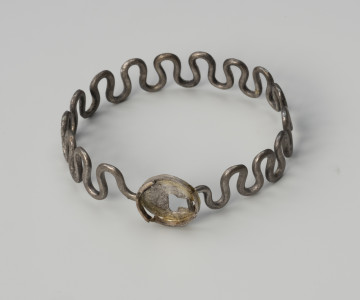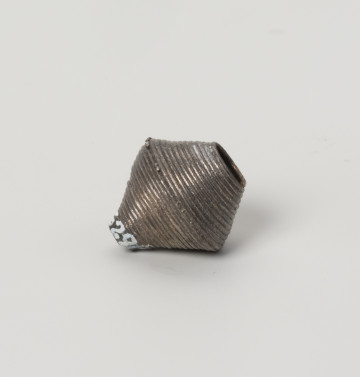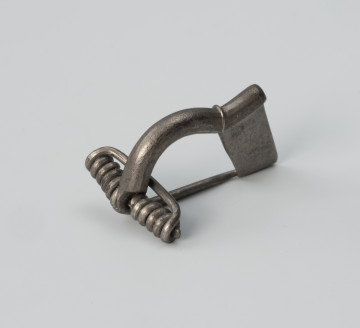
Serpentine bracelet
150 — 200
National Museum in Szczecin
Part of the collection: Antiquity
The barrow burial ground in Gronów (German. Groß Grünow) near Drawsko Pomorskie is one of the most important sites of the Wielbark culture in Pomerania. It was discovered in 1881. The first researcher of the necropolis was Pastor Plato from Zlocieniec, who carried out amateur surveys in 1881, 1887 and 1890. Another discovery took place in 1926 during the construction of the road to Zlocieniec. It was a skeletal tomb furnished with Roman imports. Between 1939 and 1940, several pit graves were encountered during the construction of the Berlin-Szczecin-Gdańsk motorway. They were excavated by the Drawsko-based social conservationists Heinz Hinz and Dr Faust. Subsequently, the area of the burial ground was reforested as the construction of the aforementioned motorway was abandoned between 1940 and 1941. The methodical excavations from which the presented fibula comes took place between 1973 and 1977 under the direction of Ryszard Wolłągiewicz (1933-1994) of the National Museum in Szczecin. A total of 56 cremated and inhumation burials were discovered in the burial ground, 49 of which were covered by barrow mounds. Dating to the 2nd half of the 2nd century, the fibula was cast in bronze and given its final shape by forging. Additionally, two combs - on the bow and above the cap covering the spring – are decorated with applications made of repoussé gold foil and silver filigree. It was part of the contents of grave No. 4, which, along with four other burials, was covered by barrow 22. Many other bronze, silver and gold ornaments such as serpentine and viper bracelets, beads of gold wire, 5 similar clasps and a clothes pin, a sigmoid buckle, a belt buckle and a small earthenware vessel were also placed in the grave of the most likely elderly woman. In addition, weaving tools and accessories were added to the grave: a decorated spinning wheel, a spinner and a hooked pin. Bartłomiej Rogalski
Author / creator
Object type
fibula
Technique
casting, forging, repoussage, gilding, filigree
Material
bronze, silver, gold
Origin / acquisition method
field research
Creation time / dating
Owner
Muzeum Narodowe w Szczecinie
Identification number
Location / status

150 — 200
National Museum in Szczecin

80 — 160
National Museum in Szczecin

80 — 160
National Museum in Szczecin
DISCOVER this TOPIC
Museum of King Jan III's Palace at Wilanów
DISCOVER this PATH
Educational path